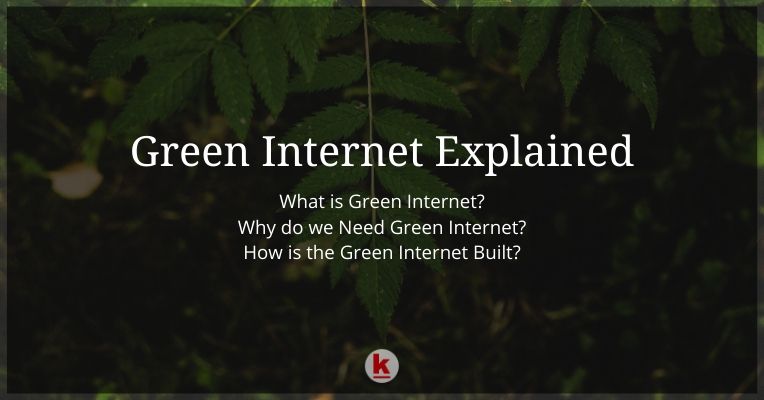
Green Internet Explained

Green Internet is a scenario where we optimize internet usage to save energy by judiciously using available resources.
The Internet is a magical place where everything is just a click away. In this digital age we are driven by social media liking and fulfill our needs by the e-commerce industry. But very few of us understand how this magic actually works.
World Wide Web is not just driven by websites, apps and data but by routers, switches, servers which make this whole ecosystem a reality. This system requires electricity – which mainly comes from non-renewable sources.
In simple words, when you ordered a pizza or binge watched your favorite Netflix show or you just tweeted about Green Internet, it caused climate-damaging CO2. So should we stop using the Internet for the sake of a green environment?
Should we stop the ever growing digital revolution?
Should we stop the process of super connected world wide web?
There is a big no for the above question and the only solution is Green Internet to restore the balance.
Why do we need Green Internet?
Surfing the internet needs energy, but above all comes the data processing units. The whole magic of the internet happens in data centers. These are responsible for almost 30 percent of the Internet’s energy requirements. In the estimated over 8 million server farms running all across the world, host of computers are deployed to process, store and transmit data.

Many countries across the world came forward for Paris Climate Agreement, to effectively minimize their carbon footprints. Holistically every sector of respective countries need to work cohesively for reduction in energy consumption, but the global IT sector and its data centers are sucking up massive energies.
In the whole internet ecosystem, data centres consumed over 270 terawatt hours (TWh) energy in 2012 and consumed 19 per cent more in 2013. Estimates made in Europe show that in 2005, internet operators had an overall network energy requirement of 14 TWh which increased to 21 TWh in 2010 and might rise to 36 TWh in 2020 if any immediate action for green internet will not be taken.

Stats mentioned above clearly indicate the amount of energy data centers consume on a daily basis. Carbon emission is the biggest problem humanity is facing today. Our planet is in danger and we are responsible to restore the balance for our mother nature.
Green Internet is not something which we want, it is needed to keep the growth climate friendly.
What is Green Internet?
Data is the new oil and fuel for future digitization. Digital technology has transformed our life by solving problems in innovative ways. The Internet is here to stay but it cannot happen at the cost of extreme energy consumption.
When we improve current (and future) set-up of the internet to minimize greenhouse gas emission and to judiciously use available energy we start to transform the internet into green internet.
Telecom companies and gadget producers will work closely to manufacture nature friendly devices induced with energy saving features. These devices will be smart to synchronise and synergize their energy-saving capabilities
Advanced analytical models are educating our designers to predict the temperature statistics advance and to provide solutions to reduce it for devices. These green devices will be of smaller size with in-built cooling systems and would lead to reduced energy consumption
Towards green IoT, many green technologies are included for example green RFID tags, green sensing network and green cloud computing network.
How we build Green Internet
Core ideology to build a green internet is to reduce energy consumption without compromising with growth. Many effective methods have been proposed and are in making.
One of the solutions for efficient energy is ECONET (low Energy COnsumption NETworks) Project and TREND (Towards Real Energy-efficient Network Design). In ECONET, engineers have modified the router hardware design and software networking platform.
The new design causes frequency switching based on load. It can work on a total of five frequencies. This change is expected to reduce power consumption
Other methods to build green internet are
- To use renewable source of energy like wind turbines and solar panels (or photovoltaics)
- To decentralize power generation units by using hydrogen power plants
- Introduce battery system solutions or virtual power plants
Conclusion
For the better future and for the sake our environment, we all must evaluate how green our current Internet is.
It is time to acknowledge and accept the harm we are doing. But ‘no internet’ is not the solution. The solution is to make the internet greener, not smaller.
If you’re motivated to bring a change with your words in the ways we consume internet, share your views and content with us in our community as a guest blogger.